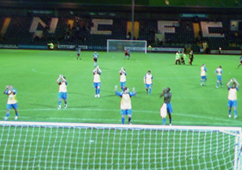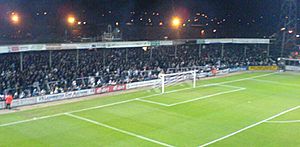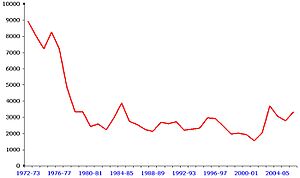Hereford United F.C. facts for kids
 |
|||
| Nickname(s) | The Bulls | ||
|---|---|---|---|
| Founded | 1924 | ||
| Dissolved | 2014 | ||
| Ground | Edgar Street | ||
| Capacity | 4,913 | ||
|
|
|||
Hereford United Football Club was a football team from Hereford, England. They played all their home games at Edgar Street. People often called them 'The Bulls' because of the famous Hereford cattle. They also had a big rivalry with Shrewsbury Town, playing in what was known as the A49 derby.
The club started in 1924. They joined different leagues and slowly became more successful. After World War II, they joined the Southern League and won their division in 1958–59 and again in 1964–65.
Hereford United became famous across England in 1972. They had an amazing win against Newcastle United, a top team, in the FA Cup. This big win helped them get into the English Football League that same year. They quickly moved up, winning the Third Division title in 1975–76. However, they only stayed in the Second Division for one season before being relegated again.
The team spent 19 years in the fourth tier of English football. In 1997, they lost their place in the Football League. They then played in the Conference for nine seasons. Under manager Graham Turner, they finished second three times in a row. They finally won promotion back to the Football League in 2006 after winning a play-off final.
In 2007–08, they were promoted again from League Two. But they were relegated the next season and then again in 2012, returning to non-League football. On 19 December 2014, the club had to close down due to serious financial problems.
After Hereford United closed, a new club called Hereford was formed. This new club keeps the spirit of the old one alive. It even includes the words 'Forever United' and the Hereford Bull in its badge. The new club has also been successful, reaching the National League North in 2018.
Contents
History of Hereford United
Hereford United Football Club was created in 1924. It was formed by combining two local teams, St Martins and RAOC (Rotherwas). The goal was to have a stronger football team in Hereford. Their first game was a 2–3 loss to Atherstone United. They also played their first FA Cup match against Kidderminster Harriers, losing 2–7.
In 1928, Hereford joined the Birmingham & District League. They played there for 11 seasons, with their best finish being 4th place. Before World War II started, they joined the Southern Football League. The club also became a limited company around this time.
After the war, Hereford had a great first full season in the Southern League. They finished first but were later placed second. Over 27 seasons in this league, Hereford finished as runners-up three times. They also won the Southern League Cup three times. In 1958–59, they won their regional division.
In 1966, Hereford signed John Charles, a famous player from Leeds United and Juventus. He became manager a year later. Charles helped build a strong team to challenge for a place in the the Football League. Hereford became one of the most popular non-league clubs.
The 1971–1972 season was very important. The club finished second in the Southern League. They also became famous for their amazing run in the FA Cup. Manager Colin Addison led the team to a famous victory over top-flight Newcastle United. Goals from Ronnie Radford and Ricky George helped them win. This cup run helped the club get elected into the Fourth Division, replacing Barrow.
The club quickly moved up the leagues. They finished runners-up in their first Fourth Division season. Then, they won the Third Division title in 1976. Dixie McNeil was the top goalscorer in England that season. However, Hereford only stayed in the Second Division for one season before going back down. Their highest point was in October 1976 when they were sixth in the Second Division.
After this successful period, the club spent 19 years in the bottom division. They faced financial problems in the 1980s and again in the mid-1990s. They had some good FA Cup moments, like a 1–1 draw with Arsenal in 1985. They also narrowly lost 1–0 to Manchester United in 1990. In the same year, they won the Welsh Cup, their first trophy in 14 years.
Graham Turner became manager for the 1995–96 season. He led the team to sixth place and the play-offs. However, they lost to Darlington. Due to growing financial issues, the club lost key players. In the 1996–1997 season, Hereford had a very bad run of games. They were relegated after a crucial match against Brighton & Hove Albion at Edgar Street.
In 1998, Graham Turner bought most of the club's shares. The club was in serious financial trouble. For many years, Turner spent very little money on new players.
The club's first five seasons in the Conference were tough. They had to sell many players, and the future of their stadium, Edgar Street, was uncertain. In the 2001–02 FA Cup, a match against Wrexham was shown live on TV. This brought much-needed money to the club. A goal by Gavin Williams in the previous round is often seen as the goal that saved the club financially.
In 2002, the club changed almost its entire squad. Many new players came from Football League clubs. This new team turned Hereford into title challengers. They finished as runners-up in the Conference for three seasons in a row (2003–04, 2004–05, 2005–06). Finally, in 2005–06, Hereford won promotion back to the Football League by beating Halifax Town in the play-off final.
The club returned to the Football League in a much better financial state. Under Graham Turner, the club managed its money carefully. They were also known for playing attractive football.
In 2007–08, Hereford had a great season. They stayed in the top five teams for most of the year. They secured third place and promotion to League One by beating Brentford 3–0.
The 2008–09 season saw the club play in the third tier of English football for the first time since 1978. However, they struggled and were often in the relegation zone. Their relegation was confirmed on 18 April 2009. Graham Turner then stepped down as manager.
Hereford was relegated again to the Conference from League Two at the end of the 2011–12 season.
On 10 June 2014, Hereford was removed from the Conference league due to financial problems. It was later revealed the club had a lot of debt. Although they were accepted into another league, financial worries continued. Many fans chose to stop supporting the club because of these issues. The club was officially closed down by the High Court in December 2014.
Colours and Badge
Hereford United first played in all-white kits. But their usual colours became white shirts and black shorts. This change happened after World War II. They used dark material from blackout curtains to make shorts when they ran out of white fabric. Sometimes, they still wore all-white kits, like in the 2004–05 and 2005–06 seasons. Their away kits changed over the years, often using yellow.
Before 1971, the club's shirts were plain with no badge. For the 1971–72 season, a picture of a Herefordshire bull was added with "H.U.F.C." below it. The badge design changed a few times over the years. The bull stayed mostly the same, but the club's full name was added around it. The final badge was introduced in the early 1990s.
For many years, Sun Valley Poultry was Hereford's shirt sponsor. They were the biggest employer in Hereford. This sponsorship lasted for 19 years, which is one of the longest in British football. Later, Cargill, Sun Valley's parent company, sponsored the shirts. In 2014, Cargill stopped sponsoring the club due to concerns about its financial situation.
Stadium
Hereford United played all their home games at Edgar Street since they started in 1924. The stadium was also used by another local club before. In later years, the stadium became a big part of Hereford's financial problems. The club had borrowed money from a company that then controlled the stadium's leases.
When the club was in the Conference league, the future of Edgar Street was uncertain. There were even plans to build a new stadium. The club and developers worked together to redevelop parts of the ground. This would include new facilities to help pay off the club's debts.
The stadium itself did not change much since the mid-1970s. It became quite old and needed a lot of work. One part of the stadium, the Blackfriars End, even failed a safety check in 2009. This reduced the stadium's capacity. Improvements were made over time to meet Football League standards. These included new floodlights, changing rooms, and barriers. The pitch was also completely relaid in 2007–08.
In 2013, the club said Edgar Street could hold 5,966 people. But in 2014, they only had a safety certificate for 1,000 spectators.
Support
Hereford United was known for having a lot of supporters, especially before they joined the Football League. Their average attendance was higher than many other clubs in higher divisions. About 10,000 Hereford fans went to the Conference play-off final.
The club's official match programme was called Bullseye. There was also a fan magazine called Talking Bull.
Home Attendances
Between 1972 and 1977, when the club was moving up the leagues, home attendances were almost 8,000 per game. Support dropped in the 1980s, with average attendances under 3,000.
Attendances improved in the later Conference years. In the 2003–04 season, the average home attendance rose to 3,704. For the 2006–07 season, the average was 3,327.
In its later years, Edgar Street rarely had full crowds. The last time over 10,000 people attended a home game was in 1990. After the stadium's capacity was reduced, the highest attendance was 8,953 in 1994 for a cup match against Nottingham Forest. The highest league attendance was 8,532 for the relegation decider against Brighton & Hove Albion in 1997.
In the 2014–2015 season, many fans decided to boycott the club's games due to problems with the club's management. This caused attendances to drop from around 2,000 to only 200–400 people.
Club Anthem
The club's official song was Hereford United (We All Love You). It was written and performed by Danny Lee, a big fan of the club. The song was first released in 1972, the same year as their famous FA Cup run. It was usually sung at every Hereford match. The song was remixed several times over the years.
Rivals
Hereford had rivalries with different clubs throughout its history. In the Southern League era, Worcester City was their biggest rival. Cardiff City and Newport County were also rivals in the 1970s and 1980s.
The derby against Shrewsbury Town was called the A49 derby. This is because the A49 road connects the two towns. This rivalry was even listed as one of the fiercest in English football. However, the new Hereford F.C. has not yet played against Shrewsbury Town.
In more recent times, after being promoted from the Conference, Hereford's rivals included Kidderminster Harriers, Cheltenham Town, and Yeovil.
Managers
Graham Turner was Hereford United's longest-serving manager. He was also one of the longest-serving managers in English football. He managed the club for almost 14 seasons.
Here are the statistics for Hereford United's four most successful managers from the 1972–73 season onwards. These numbers are for league matches only.
| Manager | Period in charge | English football levels contested | Record | ||||||
|---|---|---|---|---|---|---|---|---|---|
| P | W | D | L | Win % | Draw % | Loss % | |||
| Graham Turner | 1995–2009, 2010 | Level 3 (1 season) Level 4 (4 seasons) Level 5 (9 seasons) |
606 | 246 | 159 | 201 | 40.59 | 26.24 | 33.17 |
| John Newman | 1983–1987 | Level 4 (4.5 seasons) | 206 | 77 | 50 | 79 | 37.38 | 24.27 | 38.35 |
| John Sillett | 1974–1978, 1991–1992 | Level 2 (1 season) Level 3 (2.5 seasons) Level 4 (1 season) |
204 | 67 | 58 | 79 | 32.84 | 28.43 | 38.73 |
| Colin Addison | (1971)–1974, 1990–1991 | Level 3 (1 season) Level 4 (1 season) |
138 | 50 | 41 | 47 | 36.23 | 29.71 | 34.06 |
Notable Players
Many international players played for Hereford during its 90-year history. Brian Evans was the only player to play for his country while at the club. Gavin McCallum became the second Hereford United player to be capped and the first to score for his country while at the club, playing for Canada in 2010.
 Astrit Ajdarević
Astrit Ajdarević James Walker
James Walker Moses Ashikodi
Moses Ashikodi Marvin McCoy
Marvin McCoy Meshach Wade
Meshach Wade Kentoine Jennings
Kentoine Jennings Gavin McCallum
Gavin McCallum Jose Veiga
Jose Veiga Jarrod Bowen
Jarrod Bowen John Snape
John Snape Gary Hooper
Gary Hooper Mike Bailey
Mike Bailey Ken Brown
Ken Brown Steve Bull
Steve Bull William Churcher
William Churcher Sam Clucas
Sam Clucas Andy Todd
Andy Todd Edwin Holliday
Edwin Holliday David Icke
David Icke Joe Johnson
Joe Johnson Eric Keen
Eric Keen Terry Paine
Terry Paine Bill Perry
Bill Perry Rob Purdie
Rob Purdie Peter Spiring
Peter Spiring Mika Kottila
Mika Kottila Bruno Ngotty
Bruno Ngotty Edrissa Sonko
Edrissa Sonko Delroy Facey
Delroy Facey Péter Gulácsi
Péter Gulácsi Stephen Gleeson
Stephen Gleeson Jimmy Higgins
Jimmy Higgins Darren Randolph
Darren Randolph Kevin Sheedy
Kevin Sheedy Trevor Benjamin
Trevor Benjamin Theo Robinson
Theo Robinson O'Neil Thompson
O'Neil Thompson Eric Odhiambo
Eric Odhiambo Yoann Arquin
Yoann Arquin Wayne Dyer
Wayne Dyer Lyle Taylor
Lyle Taylor James Musa
James Musa Ade Akinbiyi
Ade Akinbiyi Tony Capaldi
Tony Capaldi Robbie Dennison
Robbie Dennison Michael Ingham
Michael Ingham Matty Lund
Matty Lund Adam Musiał
Adam Musiał Febian Brandy
Febian Brandy Jim Blyth
Jim Blyth Jonathan Gould
Jonathan Gould Michael McIndoe
Michael McIndoe Bryn Allen
Bryn Allen John Charles
John Charles Ray Daniel
Ray Daniel Nick Deacy
Nick Deacy Brian Evans
Brian Evans Roy Evans
Roy Evans Roger Freestone
Roger Freestone Ryan Green
Ryan Green Ron Hewitt
Ron Hewitt Billy Hughes
Billy Hughes Steve Lowndes
Steve Lowndes Paul Parry
Paul Parry Derek Showers
Derek Showers Derek Sullivan
Derek Sullivan Dai Thomas
Dai Thomas Nigel Vaughan
Nigel Vaughan Marley Watkins
Marley Watkins Gavin Williams
Gavin Williams
Records
After their one season in the old Second Division in 1976–77, Hereford United became the first old Third Division champions to finish last the next season. Hereford was also the last English club to win the Welsh Cup, which they did in 1990.
John Layton, Sr. holds the record for playing the most competitive games for the club, with 549 appearances between 1946 and 1964. Mel Pejic came close to this record with 523 appearances. Pejic also holds the record for most Football League appearances with 412. Charlie Thompson scored the most goals for the club, with 184 goals in all competitions between 1945 and 1958. Stewart Phillips is the only player to come close to this total with 124 goals. His 95 goals in the Football League are a club record.
Honours
Leagues
- Second Division (now EFL Championship): Best Season: 22nd position (1976–77)
- Third Division (now Football League One):
- Champions (1975–76)
- Fourth Division (now Football League Two):
- Runners-up (1972–73), Third Place (2007–08), Play-offs (1995–96)
- Conference National:
- Runners-up (2003–04, 2004–05, 2005–06), Playoff Winners (2005–06)
- Southern League:
- Runners-up (1945–46, 1950–51, 1971–72)
Cups
- FA Cup: Fourth Round (1971–72, 1973–74, 1976–77, 1981–82, 1989–90, 1991–92, 2007–08, 2010–11)
- Welsh Cup: Winners (1989–90), Runners-up (1967–68, 1975–76, 1980–81)
- Southern League Cup: Winners (1951–52, 1956–57, 1958–59)
- EFL Trophy: semi-finalists (1988–89, 1995–96, 2004–05, 2005–06, 2009–10)
- FA Trophy: semi-finalists (1970–71, 2000–01)
- EFL Cup: Third Round (1974–75)
See also
 In Spanish: Hereford United Football Club para niños
In Spanish: Hereford United Football Club para niños





